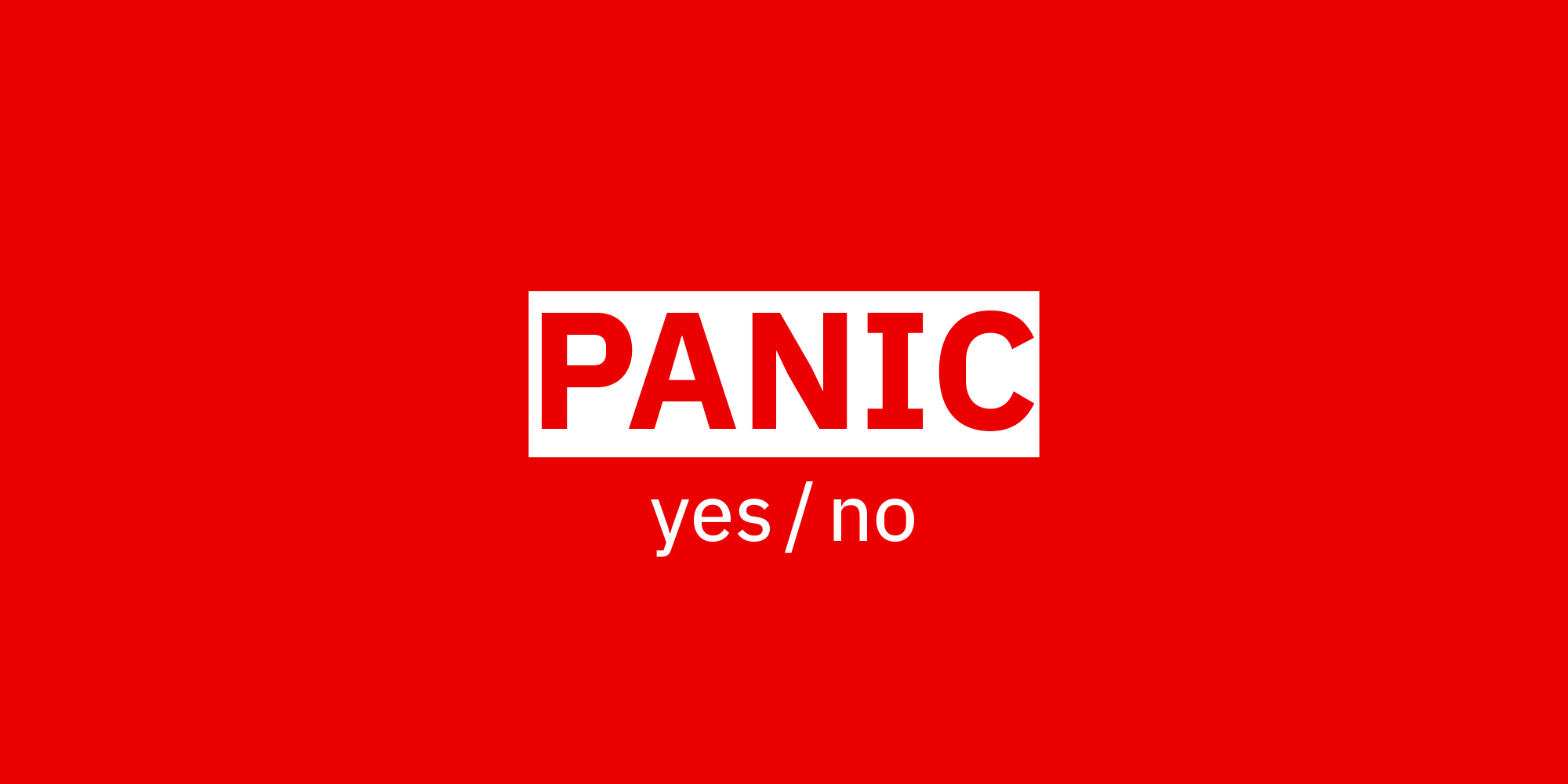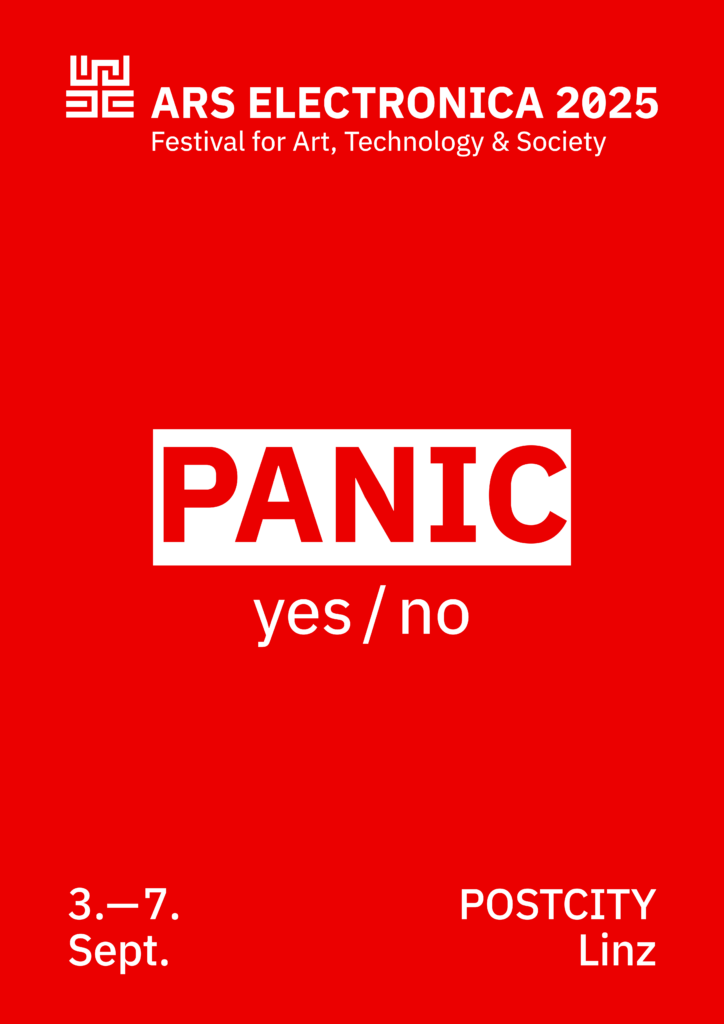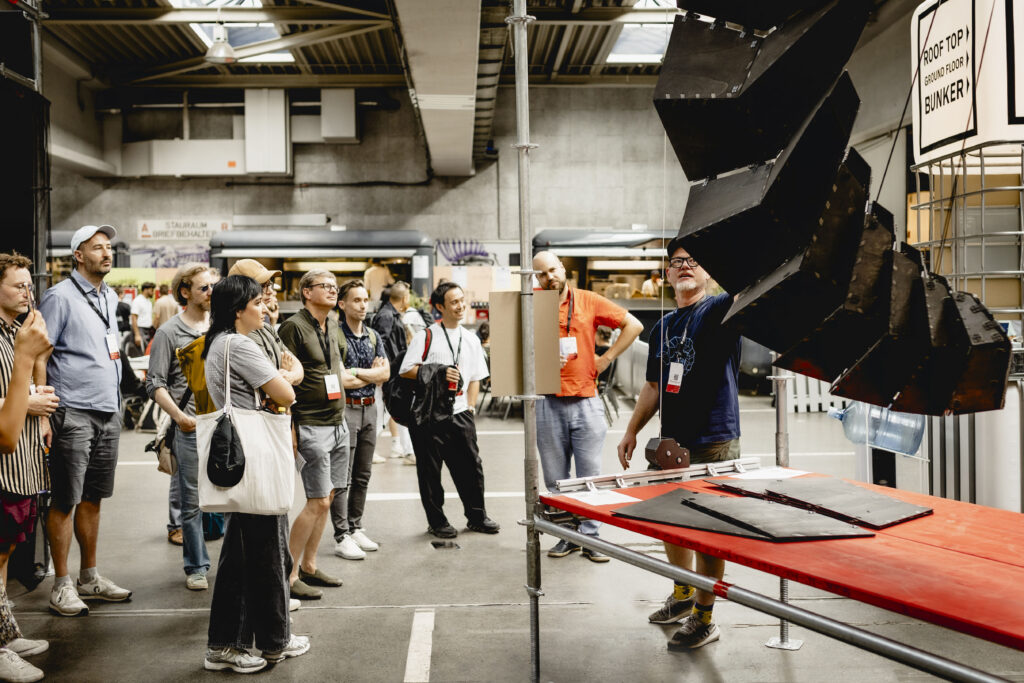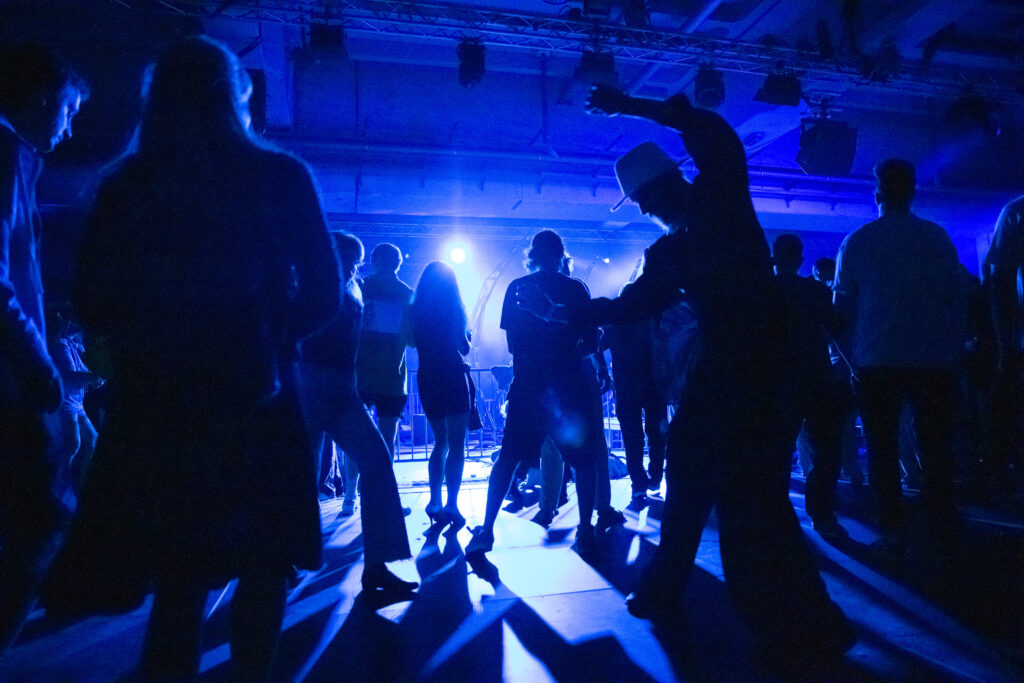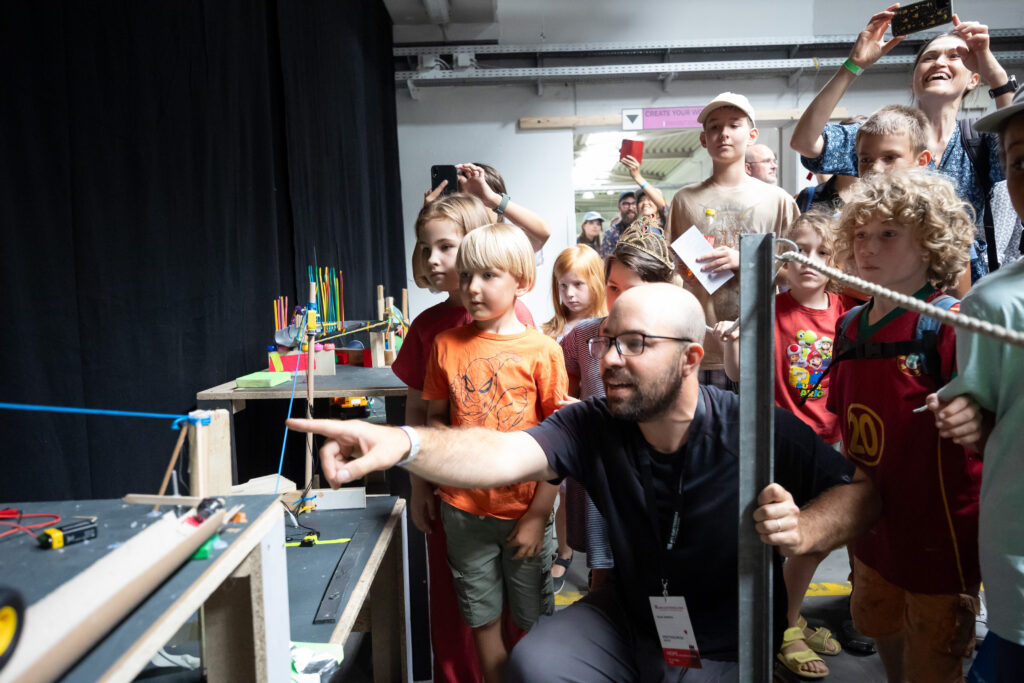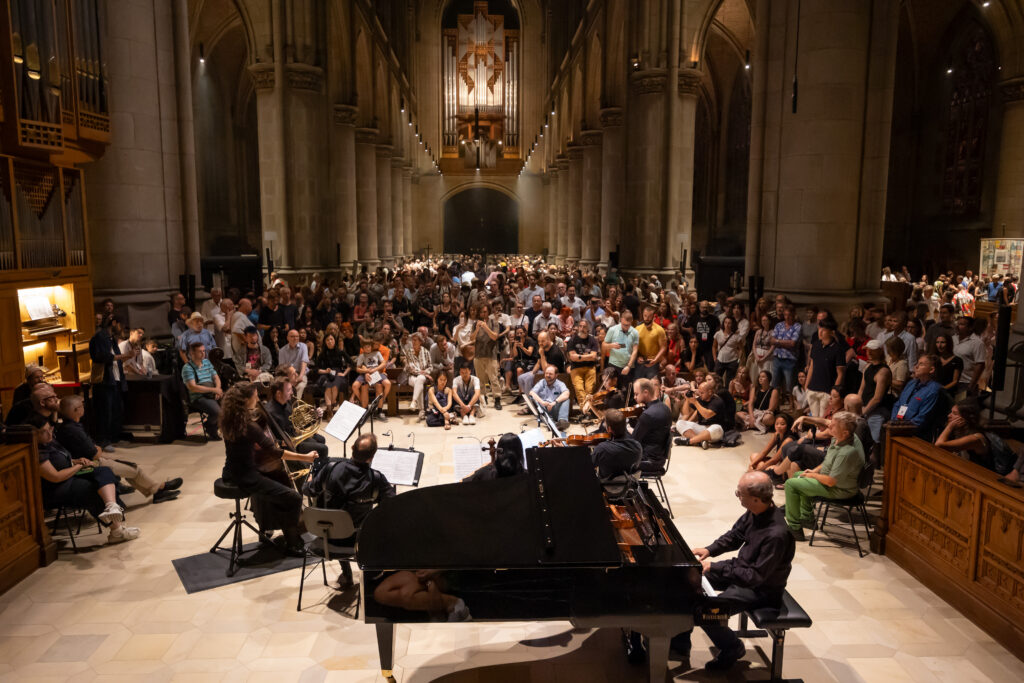- Press Release as PDF
- Photos via Flickr
- All about the Ars Electronica Festival
- Accreditation: Ars Electronica Festival 2025
- Watch the press conference on YouTube
(Linz, April 2, 2025) From September 3 to 7, Linz will again become the hotspot of the international media art scene. Spread across festival locations throughout the entire city, exhibitions, performances, concerts, and conferences will be offered and mostly take place in the POSTCITY, the main location of the festival. The title of this year’s Ars Electronica is “PANIC – yes/no.”
PANIC
yes / no
Gerfried Stocker
Artistic Director Ars Electronica
Panic, yes or no? Shouldn’t we have long been in a state of absolute panic by now? Why aren’t we? There seem to be countless reasons for panic. Or is it all just scaremongering? How long can hope last, and what will follow it?
Ars Electronica 2025
- A festival exploring the status quo of our time, a time full of contradictions and uncertainty.
- A festival about artistic work and impact in this time of profound upheaval.
- A festival for art, technology, and society at the beginning of the second quarter of the 21st century.
When we no longer understand the world around us, when things change faster than we can comprehend them, we humans apparently tend to become irrational, paying more attention to how loud a voice is than to what it is actually saying, and preferring to believe what we want to hear as truth. We find ourselves back in Plato’s cave, worshipping the shadow interpreters.
Nothing seems more disturbing than change; yet we need nothing more urgently than change. But we are increasingly unable to agree on what or who should change and how it should be accomplished.
…and what do we even mean when we talk about radical changes?
Come gather ’round people
Wherever you roam
And admit that the waters
Around you have grown
And accept it that soon
You’ll be drenched to the bone
If your time to you is worth savin’
And you better start swimmin’
Or you’ll sink like a stone
For the times they are a-changin’
When Bob Dylan wrote these lines in 1963, which are so relevant to our times, not least in view of the fact that water levels are now literally rising, the civil rights movement in the USA had reached a peak—the March on Washington and Martin Luther King’s “I have a dream” have become iconic in history—and it was clear to everyone what kind of upheaval was being talked about: new beginnings, progress, freedom, coded as ideals of the Western world, seemed so irresistibly convincing and unstoppable that it would only be a matter of time before they would prevail globally.
It was also the time in which the USA was finally able to position itself as the global hegemonic power—militarily, economically, and perhaps above all culturally, “The American Way of Life” prevailed in the free world. Politically, John F. Kennedy’s “Ich bin ein Berliner” (I am a Berliner), just a few months before he was assassinated, became the legendary symbol of a hegemonic understanding of a protective sovereign who does not subjugate, but rather motivates voluntary allegiance through the advantages and promises of his lifestyle. At least, that is how it was understood, since elsewhere people were not squeamish about using military might and nuclear deterrence as tools of power. (The 20-year Vietnam War, 1955–1975, was not fought in order to conquer the country, but rather to assert the claim to leadership.)
All that was missing was the collapse of the USSR after the fall of the Berlin Wall in 1989, and the deal seemed to be sealed. However, it had been overlooked that the economic interdependencies and dependencies resulting from globalization and the far-reaching liberalization of markets—coupled with the global digital infrastructure—would also bring about a decentralization of power structures. Not a dissolution, but a fragmentation in which power is no longer exercised exclusively through direct control or hierarchical structures, but increasingly depends on consensus building and the balancing of interests.
In the resulting hegemonic interregnum, not only did emerging geopolitical actors, especially China, position themselves, but there was also a massive shift toward technology corporations, which, with their own feudal spheres of power, evade state regulation in many areas. While the United States remains the central nervous system of global financial markets, this symbol of power has also experienced visible signs of erosion due to the dynamics of globalization and, most recently, the rise of cryptocurrencies.
Panic does not arise from the mere fear of danger, but from the realization of its inevitability—the feeling of being defenselessly exposed to it, with no possibility of escape or control.
Against this backdrop, the irrational (because it’s not based on facts and reality-based strategies) turn to oligarchic fascist ideologies, as we currently see in the USA, can certainly be seen as a panic reaction of a global power that has to face the fact that it has lost, or is about to lose, its hegemony. Frustration over the “American Decline” is accordingly one of the strongest motivations behind the MAGA narrative. Trying to explain the broad support solely with dissatisfaction over high egg prices falls short and overlooks the deeper psychology behind it.
The aggressively erratic behavior of Trump, his followers, and agitators—these castles in the air of rage and self-importance—in their force and doggedness bear clear traits of a final rebellion, a defiant denial of reality. We know how dangerous and destructive these symptoms of agony are, not only from many historical examples—it is also currently evident in Vladimir Putin’s belligerent restoration efforts and the broad approval his policies enjoy in Russia.
Of course, the same can be said about Europe’s new right-wing extremism, where the only new thing is its worryingly increased reach and the dull insensitivity with which we face these excesses.
In an unprecedentedly interconnected and digitally borderless world, people are suddenly seeking territorial boundaries and confines again; the problems of migration flows are only part of the reason for this. The sudden resurgence of interest in land ownership and physical territory, reflected in the rhetoric of those leaving the EU as well as in Trump’s fantasies of annexing Greenland and Canada, is a reaction to the loss of control that one faces in internationally and globally networked alliances. Those who cannot assert themselves in the expanse of negotiation and consensus-building would rather return to the small table and pound on it with their fists.
What we should be afraid of.
What’s brewing is a fear-driven mood, ranging from vague rejection to abysmal hatred, directed against anything that smacks of change. Against immigration, against climate activists, against diversity, against transgender people, against the realization that the world is far more complex than we’d like it to be.
Common sense is declared to have primacy over science and knowledge, and truth is no longer defined as the agreement of a statement with its subject matter, but rather as the lowest common denominator of claims that most closely correspond to what we wish for rather than what is actually happening. Regardless of the fact that 2024 was the hottest year on record, regardless of the fact that the coronavirus vaccination has saved countless people from severe illness, from long-term COVID, and even from death… etc. etc.
This erosion of truth, driven by the profit-driven algorithms of social media, is followed by the erosion of trust, perhaps the most important element for the cohesion of a society.
What is turning fear into panic, even more than the unpredictability and recklessness of the Trump administration, is the emerging disorientation now that Trump has renounced loyalty and solidarity—cornerstones of the hegemonic order since the end of World War II 80 years ago—within the entire free world (including within the United States). A disorientation as a result of which Europe is now committing itself, at breathtaking speed, to a war economy and arming itself with weapons that will be largely useless in the truly decisive battle of the coming decades: the fight against the effects of climate change.
When fear can no longer be attributed to specific dangers and risks, it turns into panic; the stress hormone adrenaline is released, the heart rate accelerates, more blood is pumped through the veins, and the muscles tense.
Do we react recklessly or do we concentrate our strength?
Fear makes us small and discouraged. How can we maintain and strengthen our momentum for the future?
How do we avoid getting stuck in the fear of uncertainty and forgetting that we can only move forward through constant change? By insisting on the status quo, we rob ourselves of the power of imagination and the courage to see the future as a viable prospect that we must shape.
And that is precisely the task of artistic work and its impact in this time of profound upheaval.
The Ars Electronica Festival 2025
POSTCITY and Festival Mile
POSTCITY, St. Mary’s Cathedral, Lentos Kunstmuseum Linz, University of Arts Linz, Atelierhaus Salzamt, Ars Electronica Center, Stadtwerkstatt, and Anton Bruckner Private University—so far, eight festival locations in downtown Linz have been confirmed and more are in planning.
In addition, there will be several Associated Venues participating in the Festival for Art, Technology and Society with their own curated programs.
An Overview of the Program
This year, too, the Ars Electronica Festival will emphasize its significance as an international platform by engaging different communities, disciplines, and sectors in a dialogue. Award-winning artists and high-ranking representatives from art and culture, renowned scientists and emerging students, entrepreneurs as well as political decision-makers from Europe and all over the world are to be expected.
Visitors can look forward to topnotch exhibitions, concerts, performances, symposia, talks, and Townhall Meetings. The multi-faceted program will consistently focus on psychological, neurological, and philosophical aspects of panic, the synchronicity of and tension between collapse, transformation, and new beginnings. Furthermore, the role of art in times of radical change will be addressed.
Events and Concerts
The Pre-Opening-Walk (Tuesday, September 2) will kick off the festival week. At the Lentos Kunstmuseum Linz, the University of Arts Linz, the Atelierhaus Salzamt, and the Ars Electronica Center, curators and artists will welcome the audience and provide exclusive insights into their exhibitions. Admission is free.
The official Ars Electronica Opening (Wednesday, September 3) will invite all visitors from Linz and international guests to celebrate the opening of the festival together. Highlight of the evening will be excerpts of the Walzersymphonie, a project by the Ars Electronica Futurelab in cooperation with four renowned music universities, commissioned for the festival year “Johann Strauss 2025 Wien”. Here, the world-famous music by the Viennese “Waltz King” becomes the subject of an inspiring research program on AI and creativity. Musicians from the Bruckner Orchestra Linz will perform, the St. Mary’s Cathedral will provide an impressive stage. The Ars Electronica Opening will be held as a guest performance of this year’s Brucknerfest. Admission is free.
The Prix Ars Electronica Award Ceremony (Thursday, September 4) at the Design Center Linz will be a further highlight of the festival week. On this evening, the focus will lie on art—and with it on the exceptional artists who were awarded the Golden Nica of the Prix Ars Electronica in 2025. In addition, the winners of the STARTS Prize, the STARTS Prize Africa, and the European Union Prize for Citizen Science will be asked to the stage—these prizes are financed by the European Union, the competitions are organized and conducted by Ars Electronica.
The Big Concert Night (Friday, September 5) in the train hall of the POSTCITY will take place in commemoration of the end of World War II 80 years ago. The chamber opera The Emperor of Atlantis or The Disobedience of Death, created 1943/44 by Viktor Ullmann and Peter Kien in the Theresienstadt Ghetto, will be staged in an interplay of orchestral music and scenically visualized performance. The production is a cooperation between Ars Electronica, the Filharmonie Brno, the Landestheater Linz, and the University of Music and Performing Arts, Vienna (mdw).
The Ars Electronica Nightline (also Friday, September 5) will invite DJ sets and performances to the train hall.
The Sonic Saturday (Saturday, September 6) at the Anton Bruckner Private University will again open up fascinating worlds of sound. This time, too, a musical highlight will take place at the Ars Electronica Center, performed in cooperation with the Brucknerfest as the opening of the Klangwolke in Deep Space 8K: With their piano concert chroma, Daniel Oliver Moser (composition) and Konstantin Semilakovs (piano and visuals) will present a piece that combines piano sounds and generative visualizations.
The Futurelab Night (Saturday, September 6) will also invite visitors to Deep Space 8K and show them how new technologies and artistic approaches can be combined to exceptional and fascinating experiences. Projects by the Ars Electronica Futurelab, including the Europe-wide XR research project SHARESPACE, will be presented.
Exhibitions
The Prix Ars Electronica exhibition is the most important exhibition of the festival and will be presented at the Lentos Kunstmuseum Linz for the second time in a row. It will feature media art projects submitted in 2025 to the categories New Animation Art, Artificial Life & Intelligence, and Digital Musics & Sound Art and awarded the Golden Nicas, Awards of Distinctions, or Honorary Mentions by the international jury.
The exhibition on the theme of the festival will be on show in the expansive bunker of the POSTCITY. In 2025, the manifold contributions will also include the results of the one-year residency program for artists in the context of the European Digital Deal (co-financed by the European Union). The works were created at renowned cultural institutions such as Onassis Stegi (GR), Braga Media Arts (PT), Waag Futurelab (NL), as well as in Linz at Ars Electronica. The Ars Electronica Features exhibition will also take place in the POSTCITY, bringing together artistic projects from partner institutions from the international network of Ars Electronica.
The S+T+ARTS Initiative (Science, Technology, and the Arts) of the European Commission will play a crucial role at the festival location of the POSTCITY, the former mail distribution center: an exclusive exhibition space will be dedicated to the award-winning projects of the STARTS Prize 2025. The STARTS Prize is funded by a group of European partner institutions, including Sónar, the Salzburger Festspiele, the TUD Technische Universität Dresden, as well as the High Performance Computing Center Stuttgart. Furthermore, with the STARTS Prize Africa exhibition and the exhibition on the European Union Prize for Citizen Science, more award-winning projects and initiatives from major European competitions will be presented at the POSTCITY.
Also on show at the POSTCITY will be the winners of the State of the ART(ist) competition as well as the Ars Electronica Award for Digital Humanity. Both are awarded by Ars Electronica and the Austrian Federal Ministry for European and International Affairs. They will be joined by works by Latin-American artists who received the CIFO x Ars Electronica Award in 2025 as well as Chilean contributions at the interface between science, technology, and media art which were selected from an open call by the Cultural Ministry of Chile, and the Foreign Relations Ministry of Chile as well as Ars Electronica.
The LIT – Linz Institute of Technology, located at Johannes Kepler University Linz, will present unique projects by JKU researchers and artists that find innovative approaches to scientific topics. The repeated involvement of the LIT deepens a long-term partnership between Arts Electronica and JKU, emphasizing the added value of a permanent exchange between art and science.
The University of Arts Linz has been a key partner of Art Electronica for more than two decades and will also provide a stage in 2025 for manifold works from its own fields of study as well as for contributions by students from international partner universities. The Ars Electronica Campus—curated by the University of Arts Linz and Ars Electronica—will span the two bridgehead buildings of the University of Arts and the POSTCITY. Works and performances by young artists, who mesmerize with creative approaches and topics, will be on show. This year’s Special Featured University in the splace gallery at the main square will be the National Academy of Art from Sofia/Bulgaria.
Conferences, Talks, and Workshops
From September 3-7, the POSTCITY will not only be a hub for a series of exhibitions but also a forum for exciting talks, presentations, and panels on the topic of the festival, which will accompany the visitors throughout the festival week. In addition, further symposia are scheduled:
In 2025, Ars Electronica will focus on education for several days. The symposium, which has been organized together with the University of Education Upper Austria for years, will be complemented by an international conference focused on the topics of democracy, media literacy, and didactics as part of the EU-funded project Critical ChangeLab.
Together with partners like the Oulu University of Applied Sciences, the European Theater Convention, and more than ten European theaters, the topic AI and Artistic Creation will be explored in the context of the EU-co-financed project ACuTe, and the focus will be placed on Digital Theater. Applications of AI in content design, production phase, ticketing, or in the field of Audience Engagement will be presented and discussed. Furthermore, a STARTS Day will also take place in 2025, providing a forum for protagonists from industry, art, and technology to discuss the digital sovereignty and future of Europe.
On January 1, 1995, Austria joined the European Union. On the occasion of this anniversary, Ars Electronica together with the Federal Ministry for Arts, Culture, the Civil Service and Sport are planning a focus event on 30 years of Austria in the EU. Furthermore, in the light of European exchange, a workshop series for culture managers at European institutions is planned for 2025. Here, the EU-funded project EXCENTRIC, which was initiated in 2025, plays a key role. It focuses on the digital transformation in cultural organizations and is realized by Ars Electronica together with institutions such as the der Erasmus University Rotterdam, KEA European Affairs, Europeana, or the European Festival Association.
Special presentations and discussions on the topic of Citizen Science—as part of the EU-funded project IMPETUS—will complete the conferences in the POSTCITY. The focus will be on pioneering methods and the question, how especially artists and young people can actively contribute to the research process.
In the Sky Loft of the Ars Electronica Center international experts will meet at the Expanded conference from September 3-5 to discuss current trends in animation art. The program of presentations and panels is organized together with the University of Applied Sciences Upper Austria – Campus Hagenberg. In line with this conference, the Atelierhaus Salzamt will once again turn into a place of innovative animations for the duration of the festival.
Specials
create your world
create your world will once again take place on the first floor of the POSTCITY. On an area of 2,000 square meters, visitors can experiment, tinker, present, and discuss—a colorful array of open workshops will make the hearts of young and young-at-heart explorers skip a beat. Highlight will be the exhibition of the projects awarded a prize in the u19 category at the Prix Ars Electronica.
A premiere will be the ceremony of the Media Literacy Award for teachers from Austria who excelled with innovative teaching concepts. The first prize of the competition, which is jointly awarded by the Austrian Federal Ministry of Education, Science and Research, Ars Electronica, and Austria’s Agency for Education and Internationalisation (OeAD), is a media education workshop for a school class worth 2,000 euros.
Ars Electronica Ecosystem
If you are interested in the role and impact of art in times of radical change, you should not only look to artists but also to institutions. Therefore, which role does Ars Electronica play and what does it aim to achieve?
Ars Electronica is “more” than simply a festival and a museum. Ars Electronica Futurelab and Ars Electronica Solutions in particular conduct research and develop for companies and industry, administration and politics, as well as clients from science and research —and want to make an impact. In the context of the festival, the teams from Ars Electronica Futurelab and Ars Electronica Solutions will, for the first time, create a common space where they will address not only what but also how and with which goals projects are implemented. The focus will be on talks and discussions on how art and culture institutions such as Ars Electronica define and implement their role in society. Which forms of innovation do Ars Electronica Futurelab and Ars Electronica Solutions want to promote? Which added value do they aim to create for whom?
Pavilion Against Indifference
The Pavilion Against Indifference will be in the POSTCITY. It is being established as part of the Flood the Zone with Courage project by Ars Electronica und Circus of Knowledge (Johannes Kepler University). The focus lies on democratic processes, forms of protest, and collective action. Visitors of the festival will be invited to actively participate in interactive workshops, live discussions, and artistic interventions.
Cultural Heritage @ Deep Space 8K
For years, Cultural Heritage has been a central part of the program of every Ars Electronica Festival. Following the Louvre, the Uffizi, the Museo Reina Sofía, and the Vatican Museums, the National Gallery London will present high-quality digitizations of artworks in Deep Space 8K.
ABOUT Ars Electronica Festival
The Ars Electronica Festival 2025 is funded by the City of Linz, the Federal Ministry for Arts, Culture, the Civil Service and Sport, the State of Upper Austria, as well as numerous sponsors and partner institutions. Historically closely tied together, the festival in 2025 will also be conducted in cooperation with ORF OÖ.
This year, too, the Ars Electronica Festival will be implemented as a Green Event—energy efficiency, careful waste management, circular use of material, as well as holistic sustainability are priorities. The festival thus contributes to reaching selected Sustainable Development Goals (SDGs) of the United Nations.
Next Announcements
In the next weeks and months all details of the program of Ars Electronica 2025 will be announced:
| Mid-May | Press release on the Cultural Heritage focus |
| End of May | Press release on the official Ars Electronica Opening |
| June | Press release on the winners of the STARTS Prize, the STARTS Prize Africa, the European Union Prize for Citizen Science, and the Media Literacy Award (MLA) |
| Early July | Press Event / Winners of the Prix Ars Electronica |
| End of August | Press Event / Program & Highlights of Ars Electronica Festival 2025 |
| September | Sept 1: Press tour at the Lentos Kunstmuseum Linz Sept 2: Press tour at the University of Arts Linz Sept 3: Press tour at the POSTCITY |
Statements
“’PANIC – yes/no’ is the title of this year’s Ars Electronica. It addresses the rapid and drastic change of our world, which questions supposed certainties and makes our future appear more uncertain than ever before. The festival raises awareness for the fact that some of us experience this as a collapse, some as a transformation, and others as a new beginning. And it highlights that panic per se is not wrong—but that it is crucial what is sets in motion within us as individuals and as a society.”
Dietmar Prammer, Mayor of the City of Linz, Owner Representative of Ars Electronica
“Especially in challenging times, perspectives for the future and visions are needed, and not ‘fearmongering.’ It is the role of art and Ars Electronica to provide us with the opportunity to engage in international exchange during times of radical change in order to address the urgent topics and questions of our time, such as democracy and participation, climate change and ecology, migration and technology, in order to continue evolving as a society.”
Doris Lang-Mayerhofer, City Councilor for Culture, Chair of Ars Electronica’s Supervisory Board
